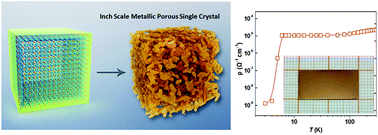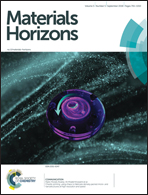Growth of 2 cm metallic porous TiN single crystals†
Abstract
Metallic porous single crystals would significantly provide enhanced functionalities owing to their structural coherence that reduces the electronic and photonic scattering effects. However, the growth of metallic porous single crystals, especially free-standing crystals at the inch scale, remains a fundamental challenge. Here we demonstrate a novel concept of growth of metallic porous TiN single crystals on an unprecedented 2 cm scale through a direct nitridation of parent SrTiO3 and TiO2 crystals in ammonia at high temperatures. The completely new growth mechanism discloses that the Sr/O evaporation coupled with the nitridation process dominates the crystal growth, while the influences of significant lattice mismatches are negligible in this gas-solid reaction. The metallic 3D-interconnected porous TiN single crystals with ∼40% porosity demonstrate an exceptionally high conductivity of ∼50 000 S cm−1, which is comparable to that of pure platinum metal. The atomic termination layer of the porous surface consists of highly active Ti3+ ions, rendering the whole surface covered with active sites. The metallic porous crystals may provide enhanced functionalities for efficient photon adsorption/emission, electron injection/extraction and molecule adsorption/activation in many energy conversion systems. The new approach opens up the possibility of designing metallic porous crystals using a wealth of other materials.



 Please wait while we load your content...
Please wait while we load your content...